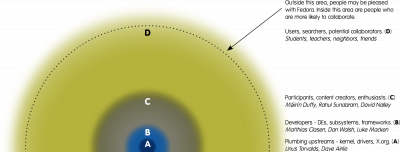From Fedora Project Wiki
| Line 21: | Line 21: | ||
** Users can become more active in the community through involvement and experience | ** Users can become more active in the community through involvement and experience | ||
** There is a line below which we ''don't'' target certain kinds of users, such as inexperienced computer users | ** There is a line below which we ''don't'' target certain kinds of users, such as inexperienced computer users | ||
* [[Meeting:Board_meeting_2010-03-18 | 2010-03-18 board meeting]] discussed proposed diagrams | |||
* [[Meeting:Board_strategic_working_group_2010-03-29 | 2010-03-29]] SWG meeting] discussed a little more and Paul is drafting a new diagram | |||
== Risk/Benefit Analysis == | == Risk/Benefit Analysis == | ||
Revision as of 13:42, 31 March 2010
Issue
"What is a target audience? Is it a concrete persona? Is it an abstract paragraph or two on a wiki?"
Background
For the past year there has have been wide ranging discussions on better defining the purpose and goals of the Fedora Project and the Fedora Distribution. Two aspects of these discussions have been been who the Fedora Project is for and who the Fedora Distribution is for. The term target audience has been used to characterize this identification.
Proposed Solutions
- Re-characterize the term Target Audience to User Base. This better reflects the board's decision around this topic in October 2009 which has often been overlooked in this disucussion:
- Our User Base or base user is a user that has the minimum level of skills, knowledge and interest as described at the User Base page.
- We want a default offering that meets the needs of these users at a minimum.
- The graphic to the right attempts to illustrate this concept.
- The pyramid used here looks and behaves like other accepted models of communities of practice
- There is a much smaller number of core contributors near the tip of the pyramid, and much larger number of users toward the base with the potential to get involved
- There is a smooth spectrum of skill and involvement from our minimum base user to a core contributor, shown by the gradient -- as opposed to a strict set of gates or levels
- Users can become more active in the community through involvement and experience
- There is a line below which we don't target certain kinds of users, such as inexperienced computer users
- 2010-03-18 board meeting discussed proposed diagrams
- 2010-03-29 SWG meeting] discussed a little more and Paul is drafting a new diagram
Risk/Benefit Analysis
- Not sure if this even applies to this topic.

